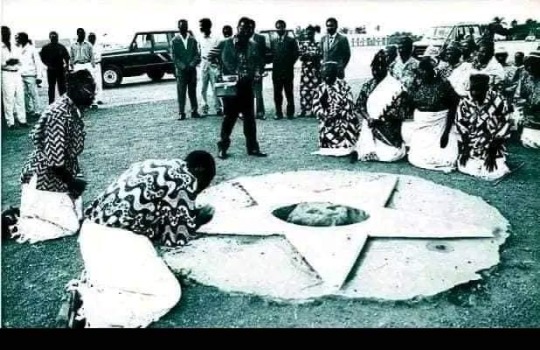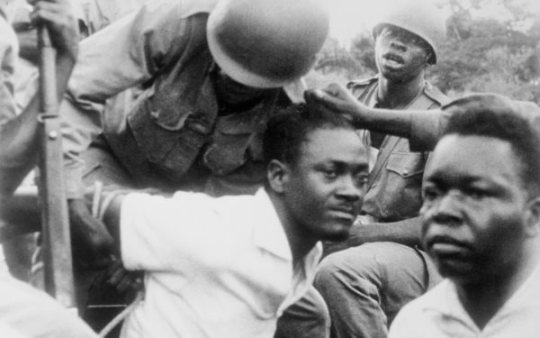#Mpolo
Text


Tomb of Mama Mpolo: Mother of the King of Kongo Mvemba to Nzinga who was buried alive.
The tomb located in Mbanza Kongo, is still a site of various traditional rituals today and remains intact and revered. Mom Mpolo is today a symbol of resistance to the destruction our ancestral culture. The king of Kongo Mvemba a Nzinga (Dom Afonso I) had his mother buried alive, as she did not want to abandon the Kongo culture to submit to Christianity.
Let us remember that the Christian king of the Kongo Mvemba Nzinga, after taking power, summoned all the leaders of the Kongo kingdom and ordered the following: "Stop honoring spells, stop believing in amulets, now that we have seen the cross of the Son of God . Anyone who dishonors them will be put to death". And as the King's mother, Dona Mpolo, did not give up her ancestral culture to embrace Christianity, the King ordered her own mother to be buried alive, to serve as an example.
Pics: The site where Mama Mpolo was buried alive.
3 notes
·
View notes
Text
Grave acidente com ônibus deixa ao menos 16 feridos, três em estado grava na PR-444 em Arapongas
Na noite de segunda-feira, 11 de dezembro, por volta das 22 horas, um acidente grave do tipo colisão traseira foi registrado em Arapongas, na PR 444, no Km 11, envolvendo um ônibus da Viação Garcia, modelo Mercedes Benz MPolo Paradiso de Londrina-PR, e um caminhão VW/24.250 CLC 440, com placa de Turvo-PR. O condutor do caminhão, J. A. J. Q., de 23 anos, saiu ileso do incidente.
No entanto, o…

View On WordPress
0 notes
Text
PRF e Receita Federal apreendem cerca de 7 kg de maconha na BR-381
Na manhã desta sexta-feira (04/08), durante ação conjunta, a Polícia Rodoviária Federal (PRF) e da Receita Federal apreenderam aproximadamente 7 kg de maconha, no km 597 da BR-381, no município de Carmópolis de Minas (MG).
A droga foi localizada em um ônibus VOLVO/MPOLO PARADISO, que havia sido apreendido na noite anterior (03/08) e era conduzido por um homem de 42 anos, que seguia de São Paulo…

View On WordPress
0 notes
Text

💣 Olympus OM-D E-M1 Fotocamera Mirrorless 16.3 MPolo Corpo
🤑 a soli 585,94€ invece di 1.299,00€
➡️ https://www.scontomio.com/coupon/olympus-om-d-e-m1-fotocamera-mirrorless-16-3-mpolo-corpo/?feed_id=40809&_unique_id=6380d66974110&utm_source=Tumblr&utm_medium=social&utm_campaign=Poster&utm_term=Olympus%20OM-D%20E-M1%20Fotocamera%20Mirrorless%2016.3%20MPolo%20Corpo
#coupon #omronhealthcare #fotoevideocamere #amazon #scontomio
0 notes
Text
ACHIOLE o ADORMIDERA
(Papaver somniferum)
Pertenece a todos los Orishas, pero sobre todo a Obatalá.
Conocida tambien como la amapola real, podemos encontrar adormidera macho y adormidera hembra, crece en el monte y tiene espinas, en Matanzas (Cuba) la llaman vergonzosa, este ewé se utiliza para anular la voluntad de una persona si se mezcla con caragua (un parsito del cedro) y guasima pulverisada, se utiliza para trabajos de amor y dominio del enemigo, en perfumes sirve para embelesar y conquistar una persona, en cocimiento para dolores de muela, se hacen buches con su cocimiento, se hacen unos cigarrillos hechos con la picadura de esta yerba, se une con mpolo de Sambia, incienso de iglesia y con el humo de este tabaco sale fuera de la muela el bicho que causa el dolor.
Es una planta anual, que alcanza una altura por encima del metro, sus hojas son velludas, sus flores pueden ser blancas, pero las más comunes son de color lila (rosa pálido), con un centro de color violeta oscuro, la cápsula, redonda y gruesa, contiene numerosas semillas pequeñas y negras y florece a partir de mayo, su recolección se realiza cuando las semillas están todavía inmaduras, contiene una savia pegajosa de color blanco y es utilizada en la fabricación del opio de manera ilegal.
El látex que contiene esta planta contiene muchos alcaloides, entre los que destaca la morfina, codeína, tebaína, papaverina, narcotina y noscapina, contiene vitamina B, lípidos, glúcidos y proteínas.
Son numerosos los insectos que parasitan esta planta, en particular hay una especie de avispa Iraella luteipes que produce agallas en los tallos de la planta, poniendo en peligro los cultivos industriales con fines farmacéuticos, alimenticios u ornamentales, se pueden controlar con agentes biológicos, en particular con hongos entomopatógenos (estos hongos son letales para los insectos y arácnidos).
La adormidera ha sido aclamada y difamada en igual medida, es una antigua planta medicinal y sirve como analgésico, antitusivo, antidiarreíco, antiespasmódico, la morfina es un analgésico muy potente pero de gran toxicidad cuando se usa para fines distintos a los médicos, es por eso que su uso se encuentra muy restringido y se reserva para casos de pacientes con intensos dolores a los que previamente se les han aplicado otros tratamientos alternativos sin ningún éxito, el uso de la codeína aparecer en muchos antigripales, también se utiliza como analgésico moderado, sus pétalos con agua hirviendo y miel,
sirven para calmar la tos y vencer el insomnio, en Lagunetas, Gran Canaria se hace un jarabe con vino, azúcar y pétalos de amapola, esta mezcla es un bálsamo para aliviar las enfermedades pectorales, las flores de la amapola son anodinas
(calman en dolor), sudoríficas, pectorales y dulcificantes, tomadas a manera de té,
en jarabe, en conserva, en tisana (infusion), ayuda a disminuir el flujo menstrual,
el jugo de sus flores es narcótico, calmante, somnífero y provechoso en la diarrea, cólicos y hemorragias
La heroína que es un derivado de la morfina, resulta altamente tóxica y su uso está totalmente prohibido, sin ninguna aplicación médica, el opio es una droga
que provoca dependencia física y psíquica (adicción), el adicto siente pronto la
necesidad de dosis superiores, lo que produce una degradación física y los
síntomas son falta de apetito, delgadez, pupilas contraidas, intolerancia a la luz,
palidez, falta de memoria, dificultad respiratoria, problemas en la piel, envejecimiento prematuro, la supresión brusca de esta droga provoca síndrome
de abstinencia caracterizado por nerviosismo, alucinaciones y ansiedad, además
como dolores de cabeza, temblores, náuseas , fiebres, insomnio y diarreas, se
emplean la raíz, las hojas y las semillas, la raíz se utiliza para la fiebre, las hojas
como tónicas y las semillas provocan el vómito.
Esta planta la utilizan en Polonia y Eslovaquia para hacer una tarta (postre tipico
de estos paises), estas son llamadas makowiec en polaco y makovník en eslovaco, en una buena parte de Europa las semillas de amapola se usan para adornar
productos de panadería y reposteria (barras de pan, bollos, etc.), también se usan
como añadido en piensos (comida) para pájaros, las semillas no contienen alcaloides, pero su aceite se usa para dar sabor en la panificación, y las semillas enteras se pueden usar para decoración.
El aceite obtenido de las semillas se aplica en la industria de la pintura como aceite secante, para la fabricación de jabones o como combustible.
El humano ha cultivado la adormidera desde hace al menos 4000 años.
Esta planta parece ser nativa del sur y este del Mediterráneo en Europa, donde fue por primera vez domesticada, se han encontrado evidencias de cultivo y uso en
asentamientos de finales de la edad de piedra, en las cercanías de los ríos Rin, Ródano, Po y Danubio, en el Lago Bracciano en Italia y Alemania, aproximadamente en el año 5700 a. C. otro hallazgo con respecto a la adormidera fue en España, en las cercanías de Granada, en una cueva llamada la Cueva de los Murciélagos, donde se encontraron cápsulas de esta planta que datan del año 4200 a. C. aproximadamente, de origen no totalmente esclarecido, en la actualidad está cultivada y naturalizada en Europa, Asia, África y América, es originaria de las regiones meditarráneas desde donde se extendió al sur y oeste de Asia, se cultiva extensamente en Asia Menor, Turquia, Persia y otros países del lejano Oriente, tambien se encuentra en Puerto Rico, Islas Vírgenes, Santa Cruz, Santo Tomas, Islas Andros en las Bahamas, Jamaica y Cuba, las adormideras no crecen en forma silvestre en Finlandia por eso se cultiva normalmente como una planta anual ornamental.
Las podemos ver en Jardines antiguos, terrenos baldíos, basureros, era una planta ornamental y tambien es silvestre.
En el Castellano se le conoce como ababolones, adormidera, adormidera blanca, adormidera lunar, adormidera negra, adormideras, adormideras blancas, adormilera, almidera, amapola, amapola blanca, amapola de adorno, amapola real, amapolona, amapola de la droga, anapola real, apio dormidera, cascal, cascales, dormidera, dormideras, dormideras blancas, hierba cascales, hierba dormidera, opio, papaver blanco, papola, papoya, en el Catalán se llama cascall, en el Gallego dormidera, en el Vasco Lobelarr, se le conoce tambien como dormidera, babolones, amapola blanca, apio dormidera, opio, papaver blanco, papola, en China la llaman veneno negro y los ingleses lo conocen como GOM (God’s Own Medicine, la propia medicina de Dios)


0 notes
Text
Discours du Premier ministre lors de la cérémonie de restitution de la dépouille de Patrice Emery Lumumba
Discours du Premier ministre lors de la cérémonie de restitution de la dépouille de Patrice Emery Lumumba
Discours prononcé par le Premier ministre lors de la cérémonie de restitution de la dépouille de Patrice Emery Lumumba.
Monsieur le Premier ministre de la République démocratique du Congo,
Excellences,
Chers membres de la famille de Son Excellence Monsieur Patrice Emery Lumumba,
et de Messieurs Maurice Mpolo et Joseph Okito,
Mesdames et Messieurs,
Permettez-moi de vous souhaiter, à toutes et à…

View On WordPress
0 notes
Text
Patrice Lumumba: 61 ans après sa mort, la Belgique restitue sa dépouille à la famille
Patrice Lumumba: 61 ans après sa mort, la Belgique restitue sa dépouille à la famille
Le 17 janvier 1961, le Premier ministre congolais Patrice Emery Lumumba était assassiné dans le Katanga avec deux compagnons de lutte Joseph Okito et Maurice Mpolo. Seule une dent a été retrouvée en Belgique des années plus tard. Et c’est cette « relique » qui a été remise à sa famille lors d’une cérémonie au palais d’Edgemont à Bruxelles, ce lundi 20 juin 2022.
« Son âme va pouvoir reposer en…

View On WordPress
0 notes
Photo


Accadde Oggi: 17 Gennaio
1961
Patrice Lumumba e due suoi fedelissimi, Mpolo e Okito, vengono fucilati a Elasbethville (oggi Lubumbashi) in Katanga.
1966
Incidente di Palomares: un bombardiere B-52 si scontra con un aereo da rifornimento KC-135 sui cieli della Spagna, sganciando tre bombe all’idrogeno da 70-kilotoni nei pressi della cittadina di Palomares e un’altra in mare. Nessuna di queste esplode.
Continua su Aforismi di un pazzo.
#Accadde Oggi#17 Gennaio#19 december 1961#Patrice Lumumba#Mpolo#Okito#Elasbethville#Lubumbashi#Katanga#Palomares#B52#KC135#Spagna#Aforismi di un pazzo#Stefano Zorba
0 notes
Photo

"Du sagst niiiieee Bescheid, wenn mal Auftritte anstehen"☝ Okay, sorry. Also: Fourgruppe inkl. mir live beim "Hip Hop Büdchen" im Rahmen des mittlerweile 4. Büdchentags in Düsseldorf! In ca. 2 Std. geht's los, wobei das Soundsystem seit 14 Uhr passend zu den Temperaturen heißläuft. Ihr habt den jährlichen Termin doch sowieso im Kalender, oder etwa nicht? 😂 Hip Hop Büdchen Lineup: Fourgruppe (Rap + Soundsystem) chrispop (Unique Records) Bindiga (Bass Connection Crew) Million (Millionadi/ Der Neue Westen) Canuto & King Lui Modusteam - Tour Stopp: 16:30 Uhr Host: Killa Calles Büdchen:Yasar Karakus, Volksgartenstraße 17, Düsseldorf-Oberbilk #fourgruppe #killacalles #kilometa #sirpreiss #djbubba #büdchenliebe #büdchentag #büdchentag2019 #chrispop #modusteam #mpolo #canuto #kinglui #million #millionadi #derneuewesten #dnw #uniquerecords #bindiga #bassconnectioncrew #hiphopbüdchen #soundsystem #liveonstage #liverap (hier: Büdchen.media) https://www.instagram.com/p/B1jMSRiCIzF/?igshid=e7ztjyktm0dd
#fourgruppe#killacalles#kilometa#sirpreiss#djbubba#büdchenliebe#büdchentag#büdchentag2019#chrispop#modusteam#mpolo#canuto#kinglui#million#millionadi#derneuewesten#dnw#uniquerecords#bindiga#bassconnectioncrew#hiphopbüdchen#soundsystem#liveonstage#liverap
0 notes
Photo

Redrawing the past 2019 version and the one from 2010 Much has changed in those 9 years. So much as my drawing style. Model in the back: @mpolobeats #redraw #inked #cartoon #caricature #illustration #art #artwork #dailysketch #dailydrawing #throwback #mpolo #düsseldorf #2019 https://www.instagram.com/p/Bs-jPwuBiEh/?utm_source=ig_tumblr_share&igshid=7lgft9bokghv
#redraw#inked#cartoon#caricature#illustration#art#artwork#dailysketch#dailydrawing#throwback#mpolo#düsseldorf#2019
0 notes
Note
quiobi, "no, we're banned from there too"
[Give me a pairing and a word/phrase, and I'll write you a drabble]
"Hm," Obi-Wan says, scrolling through the honeymoon catalogue, "Scarif looks nice."
Qui-Gon motions for Obi-Wan to hand over the datpad, unwilling to shift and displace Obi-Wan's feet from his lap. "Ah, no," he says with a grimace, looking at the pictures. "I may have caused—an incident there when I was a padawan."
Obi-Wan raises an eyebrow, taking the datapad back. "An incident."
"Misunderstanding," Qui-Gon amends, "with a local warlord. And his army."
"Ah." He scrolls through another few options. "Iytya? Lovely forests, wonderful aurora borealis."
Qui-Gon coughs. "Would that be in the Mpolo system?"
"Hm? Yes, why—oh. We're banned from there too, aren't we?"
"Mining dispute. An explosive one, if you recall."
Obi-Wan sighs, and adds it to the list of now hundreds of planets they've had to abandon as potential honeymoon destinations. "I do."
#i cannot emphasize enough how much they absolutely deserve this#make stupid choices win stupid prizes#prompt game#quiobi#anon#star wars
98 notes
·
View notes
Text


This is IMPORTANT — you should know and understand this bit of history...
Patrice Lumumba: May Africa breathe the air of freedom
... Between 1880 and 1920, the Congo lost approximately half of its population. An estimated eight to ten million Africans died as victims of King Leopold’s “rubber-terror.” There is the infamous picture of a Congolese worker called Nsala who was presented with the severed hand and foot of his five-year-old daughter, Boali, as punishment for him failing to meet his rubber quota for the day.
Despite these terrors, initially, Lumumba expressed his sympathy for the Belgian colonisers, he rejected independence as premature, and was favourable to the creation of a federation uniting Belgium and Congo as a continuation of the colony of the Congo.
Lumumba’s faith in the system began to waver when realized that despite the many efforts required for attaining a higher status, the Congolese remained less than human in the eyes of the Belgians. And nothing could change that. Because Congolese status was tied to their Blackness. And nothing could change that. When Lumumba saw other African states achieving independence, his resolve for Congolese independence was strengthened. Kwame Nkrumah of Ghana encouraged Lumumba to be Pan-African. So, Lumumba founded the Mouvement National Congolais (MNC) in 1958, a political party, to help realize the Pan-African project. In his view, a unified and independent Congolese state, representing all the Congolese people democratically, was a prerequisite for joining the rest of Africa in accomplishing the Pan-African dream.
After extensive negotiations between the Belgians and the Congolese nationalist leaders – including Lumumba – elections were planned for May and June 1960 and independence was scheduled for 30 June 1960. A coalition led by Lumumba won the elections and he was appointed Prime Minister of the new government with Joseph Kasa-Vubu as President. At independence he gave a strident speech which vilified the colonial order and eulogised the struggle that brought it to an end, saying ‘We are proud of this struggle, of tears, of fire, and of blood, to the depths of our being, for it was a noble and just struggle, and indispensable to put an end to the humiliating slavery which was imposed upon us by force.’
Many in the West were alarmed by his speech. And with that speech, as the events that followed suggest, Patrice Lumumba may have signed his own death warrant.
On the 11th of July, with the support of the Belgian government, Katanga – the mineral-rich economic heart of the Congo – seceded. In the ensuing chaos, Lumumba was dismissed as PM by Kasa Vubu on the 5th of September 1960. Lumumba in turn took over the radio airwaves to denounce and depose Kasa-Vubu as a traitor. The constitutional crisis this created was ended by a coup in September of 1960 led by Colonel Mobutu (more about him later). Lumumba was arrested on the 1st of December. His imprisonment proved to be a source of sectarian tension. So on 17 January 1961, he was forcibly put on a plane to Elizabethville. On arrival, he and his associates were conducted under arrest to the Brouwez House where they were brutally beaten and tortured by Katangan and Belgian officers.

Later that night, Lumumba was driven to an isolated spot where three firing squads had been assembled. A Belgian commission of inquiry found that the execution was carried out by Katanga’s authorities. It reported that President Tshombe and two other ministers were present, with four Belgian officers under the command of Katangan authorities. Lumumba, Maurice Mpolo and Joseph Okito were lined up against a tree and shot one at a time. The execution is thought to have taken place on 17 January 1961, between 21:40 and 21:43 (according to the Belgian report). The Belgians and their counterparts later wished to get rid of the bodies, and did so by digging up and dismembering the corpses, then dissolving them in sulfuric acid while the bones were ground and scattered...

Prime Minister Patrice Lumumba of Democratic Republic of the Congo, Brussels, January 26, 1960
See also:
- Patrice Lumumba’s Independence Day speech, June 30, 1960
61 notes
·
View notes
Photo

AFRICANGLOBE – Since January 17, 1961, no one has been held accountable for the brutal murder of Congo’s independence leader and first prime minister Patrice Lumumba who was shot dead with two of his ministers, Joseph Okito and Maurice Mpolo. However, all fingers point to multinational perpetrators who sanctioned the elimination of one of Africa’s bravest politicians and independence heroes who stood his ground against colonizers.
https://www.africanglobe.net/africa/chilling-details-patrice-lumumbas-assassination-dissolved-acid/
5 notes
·
View notes
Text
La lettera scritta per la moglie poco prima di morire ci lascia il profilo più autentico di Patrice Lumumba, con tutti gli accenti che solitamente infiammavano i suoi discorsi: "Mia cara compagna, ti scrivo queste righe senza sapere se e quando ti arriveranno e se sarò ancora in vita quando le leggerai. Durante tutta la lotta per l'indipendenza del mio paese, non ho mai dubitato un solo istante del trionfo finale della causa sacra alla quale i miei compagni ed io abbiamo dedicato la vita. Ma quel che volevamo per il nostro paese, il suo diritto a una vita onorevole, a una dignità senza macchia, a un'indipendenza senza restrizioni, il colonialismo belga e i suoi alleati occidentali – che hanno trovato sostegni diretti e indiretti, deliberati e non, fra certi alti funzionari delle Nazioni Unite, quest'organismo nel quale avevamo riposto tutta la nostra fiducia quando abbiamo fatto appello al suo aiuto – non lo hanno mai voluto. Hanno corrotto dei nostri compatrioti, hanno contribuito a deformare la verità e a macchiare la nostra indipendenza... Morto, vivo, libero o in prigione per ordine dei colonialisti, non è la mia persona che conta. E' il Congo, il nostro povero popolo... Ma la mia fede resterà incrollabile. So e sento in fondo a me stesso che presto o tardi il mio popolo si solleverà come un sol uomo per dire no al capitalismo degradante e vergognoso e per riprendere la sua dignità sotto un sole puro... Ai miei figli, che lascio e forse non rivedrò più, voglio che si dica che il futuro del Congo è bello e che aspetta da loro, come da ogni congolese, che completino il compito sacro della ricostruzione della nostra indipendenza e della nostra sovranità, poiché senza dignità non c'è libertà, senza giustizia non c'è dignità e senza indipendenza non ci sono uomini liberi. Né le brutalità, né le sevizie né le torture mi hanno mai spinto a domandare la grazia, perché preferisco morire a testa alta, con la mia fede incrollabile e la fiducia profonda nel destino del mio paese, piuttosto che vivere nella sottomissione e nel disprezzo dei sacri principi. La storia si pronuncerà un giorno, ma non sarà la storia che si insegnerà a Bruxelles, a Washington, a Parigi o alle Nazioni Unite, ma quella che si insegnerà nei paesi liberati dal colonialismo e dai suoi fantocci. L'Africa scriverà la sua storia, una storia di gloria e di dignità a nord e a sud del Sahara. Non piangermi, compagna mia. Io so che il mio paese, che tanto soffre, saprà difendere la sua indipendenza e la sua libertà".
Il 17 gennaio 1961 Patrice Émery Lumumba, insieme a due suoi fedeli (Mpolo e Okito), fu trasferito in aereo a Elisabethville (l'attuale Lubumbashi), in Katanga, e consegnato nelle mani di Moïse Kapenda Tshombé. Era stato catturato il 2 dicembre 1960 dai soldati di Joseph-Desiré Mobutu mentre, dopo essere evaso dalla sua prigione domiciliare vigilata dai caschi blu dell?Onu, stava per riparare a Stanleyville, al di là del fiume Sankuru. Verso le 10 di sera di quello stesso giorno, lungo di viaggi e torture, un plotone al comando di un ufficiale belga fa fuoco su di lui e sui due suoi compagni. La mattina successiva i resti di Lumumba, Mpolo e Okito vengono fatti sparire nell'acido e molti dei sostenitori dell'indipendenza congolese giustiziati nei giorni seguenti con la partecipazione di mercenari belgi.
Tshombé è presente all'esecuzione. Lui, che appena sei mesi prima aveva promosso le sommosse nel Katanga, una regione meridionale del Congo belga scandalosamente ricca di minerali preziosi, decretandone la secessione al soldo del governo belga, della CIA e nel silenzio frastornante delle Nazioni Unite. Perché Patrice Lumumba, divenuto primo Primo Ministro del Congo indipendente il 23 giugno 1960 a capo del MCN (poi diventato MNCL, Movimento Nazionale Congolese di Liberazione), aveva creato più di un fastidio alle politiche imperialiste dell'Occidente cosiddetto "democratico". Se le autorità belghe (e soprattutto le compagnie minerarie) non pensavano ad un'indipendenza piena ed intera (una buona parte dell'amministrazione e i quadri dell'esercito restavano belgi), Lumumba sfidò l'ex potenza coloniale decretando l'africanizzazione dell'esercito e rendendo il popolo congolese il vero motore di questa storica indipendenza (a dispetto del re del Belgio, Baldovino, che con stile paternalistico aveva annunciato «Noi vi abbiamo aiutato a raggiungere l'indipendenza... »). Le parole di questo leader carismatico suonavano come un monito alle orecchie degli sfruttatori, dei coloni parassiti e dei politicanti ambigui del Congo indipendente (come ad esempio il Presidente Kasa-Vubu, che nel settembre non esiterà a revocare gli incarichi di Lumumba e degli altri ministri nazionalisti, salvo poi essere destituito dal parlamento poco dopo): «Noi abbiamo conosciuto le ironie, gli insulti, le sferzate, e dovevamo soffrire da mattina a sera perché eravamo negri. Chi dimenticherà le celle dove furono gettati quanti non volevano sottomettersi a un regime di ingiustizia, di sfruttamento e di oppressione?».
Lumumba fu per questo molto rimpianto da tutta la comunità dei paesi non allineati e da numerosi esponenti politici (quali ad esempio Che Guevara che protestò vibrantemente contro il suo assassinio). In Lumumba, però, non individuiamo il profilo del classico rivoluzionario, non possiamo nemmeno arruolarlo tra le fila dei tanti intellettuali filosovietici di quegli anni, poiché egli non si definiva comunista: Lumumba era un'idealista profondamente convinto dei suoi principi, capace di radicalizzarsi nei discorsi e nei metodi quando le contingenze lo richiedevano.
div > .uk-panel'}" data-uk-grid-margin="" style="display: flex; flex-wrap: wrap; margin: 0px 0px 0px -30px; padding: 0px; list-style: none;">
1 note
·
View note
Link
Revolutionary endeavors of today, because they have to break all the rules of false understanding imposed by the “peaceful coexistence” of reigning lies, begin in isolation, in one particular sector of the world or in one particular sector of contestation. Possessing only the most rudimentary conception of freedom, they attack only the most immediate aspect of oppression. As a result, they meet with the minimum degree of aid and the maximum of repression and slander (they are accused of rejecting one existing order while necessarily approving of an existing variant of it). The more difficult their victory, the more easily it is confiscated by new oppressors. The next revolutions can find aid in the world only by attacking this world as a whole. The freedom movement of the American blacks, if it can assert itself incisively, will call into question all the contradictions of modern capitalism; it must not be sidetracked by the “black nationalism” and “black capitalism” of the Black Muslims. The workers of the United States, like those in England, are engaging in “wildcat strikes” against the bureaucratized unions that aim first of all at integrating them into the concentrated, semiregulated capitalist system. It is with these workers and with the students who have just won their strike at the University of California in Berkeley that a North American revolution can be made; and not with the Chinese atom bomb.
The movement drawing the Arab peoples toward unification and socialism has achieved a number of victories over classical colonialism. But it is more and more evident that it must finish with Islam, an obviously counterrevolutionary force as are all religious ideologies. It must grant freedom to the Kurdish people. And it must stop swallowing the Palestinian pretext that justifies the dominant policy in the Arab states — a policy that insists on the destruction of Israel and thereby perpetuates itself since this destruction is impossible. The repressive forces of the state of Israel can be undermined only by a model of a revolutionary society realized by the Arabs. Just as the success of a model of a revolutionary society somewhere in the world would mean the end of the largely sham confrontation between the East and the West, so would end the Arab-Israel confrontation which is a miniature version of it.
Revolutionary endeavors of today are abandoned to repression because it is not in the interest of any existing power to support them. So far, no practical organization of revolutionary internationalism exists to support them. We passively watch their combat and only the delusory babble of the UN or of the specialists of “progressive” state powers accompanies their death throes. In Santo Domingo US troops dared to intervene in a foreign country in order to back up fascist army officers against the legal government of the Kennedyist Caamano, simply for fear that he would be overwhelmed by the people he had had to arm. What forces in the world took retaliatory measures against the American intervention? In the Congo in 1960 Belgian paratroopers, UN expeditionary forces and the Mining Association’s tailor-made state [Katanga] broke the impetus of the people who thought they had won independence, and killed Lumumba and Mpolo. In 1964 Belgian paratroopers, American transport planes, and South African, European and anti-Castroist Cuban mercenaries pushed back the second insurrectional wave of the Mulelists. What practical aid was provided by “revolutionary Africa”? A thousand Algerian volunteers, victors of a much harder war, would have been enough to prevent the fall of Stanleyville. But the armed people of Algeria had long been replaced by a classical army on lease to Boumédienne, who had other plans.
The next revolutions are confronted with the task of understanding themselves. They must totally reinvent their own language and defend themselves against all the forms of cooption prepared for them. The Asturian miners’ strike (virtually continuous since 1962) and all the other signs of opposition that herald the end of Francoism do not indicate an inevitable future for Spain, but a choice: either the holy alliance now being prepared by the Spanish Church, the monarchists, the “left Falangists” and the Stalinists to harmoniously adapt post-Franco Spain to modernized capitalism and to the Common Market; or the resumption and completion of the most radical aspects of the revolution that was defeated by Franco and his accomplices on all sides — the revolution that realized truly socialist human relationships for a few weeks in Barcelona in 1936.
The new revolutionary current, wherever it appears, must begin to link up the present contestatory experiences and the people who bear them. While unifying such groups, it must at the same time unify the coherent basis of their project. The first gestures of the coming revolutionary era embody a new content, both visible and hidden, of the critique of present societies, and new forms of struggle; and also the irreducible moments of all the old revolutionary history that has remained in abeyance, moments which reappear like ghosts. Thus the dominant society, which prides itself so much on its constant modernization, is going to meet its match, for it is at last beginning to produce its own modernized negation.
Long live the comrades who in 1959 burned the Koran in the streets of Baghdad!
Long live the workers councils of Hungary, defeated in 1956 by the so-called Red Army!
Long live the dockers of Aarhus who last year effectively boycotted racist South Africa, in spite of their union leadership and the judicial repression of the Danish social-democratic government!
Long live the “Zengakuren” student movement of Japan, which actively combats the capitalist powers of imperialism and of the so-called “Communist” bureaucracies!
Long live the workers’ militia that defended the northeastern districts of Santo Domingo!
Long live the self-management of the Algerian peasants and workers! The option is now between the militarized bureaucratic dictatorship and the dictatorship of the “self-managed sector” extended to all production and all aspects of social life.
4 notes
·
View notes
Text
Mise au point du cadastre minier sur la gestion du Fonds minier (communiqué)
Mise au point du cadastre minier sur la gestion du Fonds minier (communiqué)
REPUBLIQUE DEMOCRATIQUE DU CONGO CADASTRE MINIER
Téléphone: (+243) 858 193 909
Email: [email protected]
Website: www.cami.cd
Twitter : @CadastreMinier
Facebook : Cadastre Minier RDCongo
DIRECTION GENERALE
Croisement des Avenues Mpolo Maurice et Kasa-Vubu, GOMBE
Numéro Impôt : A0700326N
BP 7987, Kin 1 KINSHASA
COMMUNIQUE DE PRESSE
Depuis quelques jours, le Cadastre Minier est victime, à travers son…

View On WordPress
0 notes